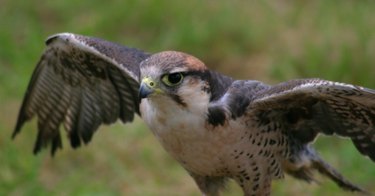
Placing a bird feeder in your backyard attracts a wide variety of wildlife. Not only are songbirds attracted to these free meals, but also raccoons, squirrels, rabbits and other small animals that feed on the seed dropped by the birds. However, such a concentration of small animals can attract unwanted visitors as well, such as hawks that feed on small prey. You can frighten the hawks away from the bird feeder.
Visual Scares
Video of the Day
Hanging visually frightening deterrents in areas that attract hawks can keep the songbirds at your bird feeders safe. For example, hanging shiny pie tins from the tall trees near your home can frighten hawks. The tins reflect sunlight, creating the illusion of movement in a way that the hawk will not understand and fear. Small scarecrows or balloons placed high in trees have a similar effect. If the songbirds spot these they may be frightened as well, but the songbirds likely approach from lower down from nearby shrubs and smaller trees, while hawks attack from above. Visual deterrents are less likely to scare the smaller birds for this reason.
Video of the Day
Audio Scares
Audio scares are more dramatic and should only be used if necessary. These scare techniques are effective if employed when you can see the hawk and know that it is watching the birds near your feeder. Nearly any loud noise scares away the hawks, so if you are close enough something as simple as banging a few pots together or clapping and yelling may work. You may have to do this several times before the hawk stay away for good, and this may scare away some of the desired birds as well, at least temporarily.
Laser Pointers
Laser pointers are effective in scaring away hawks, especially at night or near dusk. Point the laser a few feet in front of the hawk on the branch or tree and slowly move it toward the hawk, wiggling it to ensure it catches the hawk's attention. When the hawk cannot determine what it is and it continues to get closer, the predator flies away from the perceived threat.
Prevention
Remember that it is illegal in most areas to try to capture or kill a wild hawk. However, there are preventative measures that keep birds safe at your feeder. Position the feeder next to tall bushes or shrubs where small birds can dart as soon as they see a hawk nearby. Some feeders come in cages with holes large enough for small songbirds but too small for large hawks. Finally, taking down the feeder for a week to 10 days will make the hawk think that the small birds are not coming back, and the predator will move to a different hunting area. Rehang the feeder after the hawk threat passes.